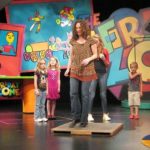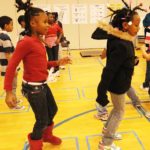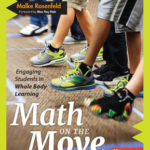Math Can Be Learned Through the Feet
posted by Emily Grosvenor
Q & A: For dancer, educator and homeschooling mom Malke Rosenfeld, math can be learned through the Feet
Educator Malke Rosenfeld believes she had a typical relationship to math as a child.
“I went K-12 through public school disenchanted with math, never feeling personally connected,” Rosenfeld said. “I always wanted to know the “why” of math but never getting a satisfactory answer.”
For years, she asked the same question, never finding something that clicked. But one day, at a dance workshop in California, after donning a pair of golden tap shoes to learn a French Canadian waltz clog, she realized her feet could be a percussive instrument. This was just the beginning for the creator of Math in Your Feet©, an interdisciplinary approach to learning math through dance. In her new book, Math on the Move, just out from Heinemann Publishing, Rosenfeld takes the idea that it isn’t just the mind, but the mind and the body, that synthesizes learning. Math and dance, it turns out, are mighty bedfellows.
I spoke with Malke Rosenfeld about the Math in Your Feet© program she brings to classrooms as a visiting artist and what children can learn about math through dance.
Emily: When was the turning point for you for discovering that math and dance can be combined for learning? Can you describe that moment?
Malke Rosenfeld: After about five or six years of touring with my Celtic band and teaching in the Carolinas my husband got a great job opportunity in Indiana. During the first year or so after we moved I started substitute teaching in local schools. I got placed in a lot of resource rooms and elementary classrooms and interacted with a LOT of kids who were disenchanted with the whole math thing. I thought back to the Drum with Your Feet program I had created about six years earlier, where kids were engaged and highly creative once they were given personal agency to make something on their own. After one particularly difficult day with kids in the resource room I thought to myself, “I wonder if there is math in what I already do with kids?” The idea stuck in the back of my head for a while and then, one night, I had a dream where the whole concept of Math in Your Feet came to me – I woke up knowing I first needed a math education expert to help me make meaningful connections between the disciplines; I wanted to create a five-day math-and-dance residency; I wanted to eventually create teacher PD to help them experience and learn to use this approach in their own classrooms. Finally, I wanted to create a set of curricular materials to support teachers in the implementation of the math and dance work. My new book is the final piece of the puzzle.
Emily: Can you think of any formative moments that changed your relationship to math?
Malke: I think that my relationship to math changed slowly, and over time, for the better as an adult about five years into my teaching career. I had no math anxiety at all when I first came up with the idea
for Math in Your Feet. I knew from my early meetings with my co-collaborator Jane Cooney that I was on to something and the biggest challenge for me was to figure out how to give the math and the dance the same amount of attention in the classroom. In an interdisciplinary context like this we can’t make up the math to fit the dance, or make up the dance to fit the math. So, it takes a little extra effort to see them both happening at the same time.
Overall, I was mostly just curious if my idea would work and was ready to learn as much as I could. Elementary math turned out to be a wonderful place for me to hang out because it’s got big ideas that are absolutely fascinating to me! The idea of composing and decomposing objects or numbers, and thinking about the relationship between parts and wholes totally connects with what I do as a dancer. Thinking about sameness and difference is a happy place for me and, again, is one of the main ways we make our choreography interesting. Finding, making, and describing patterns and exploring transformations is just fantastic fun.
My relationship to math deepened even further when I needed to homeschool my daughter for first and second grades due to health reasons. I used our days as an opportunity for me to experience elementary math learning up close and personal, and as a chance to (re) develop my number sense from the ground up. My biggest resources were the Natural Math and Let’s Play Math! blogs. As I explored and remixed math activities with my daughter I noticed a change in myself. I had found a kind of math experience that was personally relevant to me as a creative, visual, interesting, and conversational experience. It was similar to what we were already doing in Math in Your Feet, but that is the students’ experience, not mine. This time I was experiencing it from the inside! Playing math with my kid helped me (re) build my number sense along with my kid and it was fun to enjoy playing with numbers. One time she was filling in a hundred chart and finding patterns. She exclaimed “I feel like I’m IN the chart, mama!” We also went on lots and lots of math walks around town and found and talked about the math we discovered. It was a mathematically rich few years.
Emily: Why have you decided to devote yourself to this interdisciplinary pursuit?
Malke: If you could peek into my mind you would see a huge, multi-ringed Venn diagram. I see the big picture first and am always seeing overlaps and connections between disparate ideas. Traditional K-12 curriculum presents subjects in isolation from each other but my experience is that learners benefit greatly when they have a chance to explore those places of overlap. The big picture mathematics is about exploring relationships between one idea or object and another. We do the same when we find a nice overlap between two disciplines and this gives us the opportunity to expand our understanding of the world as a whole, not just its individual parts.
Emily: How would you explain “body knowledge” to someone who has never heard of it?
Malke; “Body knowledge” is a phrase coined by the late Seymour Papert who essentially invented computer programming for kids. His work intentionally harnessed the child’s lived experiences in the world as a way to investigate more formal mathematics via computer programming of a little object he
called “turtle.” A lot of this work is similar to the Math in Your Feet work – children working independently or in teams within a specific system/constraint, investigating and creating units of commands or patterns in a spatial and geometric language and, along the way, fine tuning their intentions and results.
 We can use body knowledge (more formally known as embodied cognition) in a couple of ways for math learning. The first is to change the scale of a mathematical activity from static, 2D form on a piece of paper to “body – or moving-scale.” In this case we make the investigation big enough for the whole child to be up and moving. An example of this is a large number line or hundred chart taped on the floor. This new scale has the potential to create new insights and understanding in the learner.
We can use body knowledge (more formally known as embodied cognition) in a couple of ways for math learning. The first is to change the scale of a mathematical activity from static, 2D form on a piece of paper to “body – or moving-scale.” In this case we make the investigation big enough for the whole child to be up and moving. An example of this is a large number line or hundred chart taped on the floor. This new scale has the potential to create new insights and understanding in the learner.
In Math in Your Feet we are building body knowledge. The constraints of the dance system require children to enact specific foot positions, movements, and directions to create their patterns. As they do so there is potential for them to be developing new skills and understanding of the mathematical ideas we are using during the choreography.
Emily: I like this idea that it’s not learning object that is memorable or important in learning, but the context. How does Math in Your Feet provide context for learning?
Malke: The context of learning for Math in Your Feet is that we take this idea that experience is key to learning and encounter math in an utterly new and novel way. And, not only that, we explore the math/dance overlap in multiple modes: we use it to make dance patterns, we talk about it, we use it to compare and contrast one dance idea to another, communicate and makes sense of it through written reflections, maps, word studies, and our own performance. No one representation can express a math idea in full; no one learning mode allows the learner, and especially our young learners, to make sense of an idea and make it their own. Emily: What are the mathematical concepts that children can learn Math in Your Feet?
Malke: I have a whole chapter in the book titled “How is this Math?” In it, I go into great detail with lots of examples of how the moving body is best positioned to express the verbs of math. So often we think of math as the objects or nouns of math, the things we can point to on the page, that don’t move, that are in the perfect position to be identified and talked about. When we have the opportunity to explore the verbs of math by reasoning and thinking spatially with our bodies, physically exploring composition and decomposition of units and patterns, or enacting one or multiple rotations, transforming an object in real time, children get a chance to almost literally wrestle with highly action oriented math ideas, things we can’t always understand by looking at static images on the page. Mathematical practices are the ultimate mathematical verb and are about what we do and how we think as we endeavor to solve mathematical questions. Most of us left school without ever getting a chance to really get to know the action side of math; what better way for elementary school learners to make friends with and explore this kind of math than with a whole, moving body?
Emily: Math in Your Feet seems to create a powerful opportunity for spatial learning. Why is spatial learning important to math? From your book it seems like it’s the great connector, the thing that makes math meaningful to everyone.
Malke: Spatial reasoning is the foundation of mathematical thought and critical to mathematical achievement. It is also one of the verbs of mathematics that helps us “do” math. We use spatial concepts every day in math class to help us make sense of and learn math. For example, a number line is a spatial construct that helps us visualize amount, magnitude, operations, and even negative numbers. Arrays, calendars, and analog clocks are all spatial objects that help us makes sense of numbers in different by ordering information in structured ways. We are all born with the capacity to think spatially, and our cognition is literally built from birth through our physical explorations of the space we live in. Spatial and math concepts refer back to our experiences moving and living in and through our lived physical spaces. The more we include and develop spatial tasks and skills in our learners, or at least recognize their presence in our math classrooms, the better off our learners will be.
Emily: Can you talk about what you do when you visit a class?
Malke: Basically I introduce myself, and then get them dancing with me as soon as possible. I have learned from long experience that nothing I say at the start of our time together will make any sense at all. Children need to explore and experience something tangible first before the concepts make sense; these kind of experiences give them something tangible to think and reason about and from their conversations can begin.
After we have some dancing under our belt and we have previewed the big picture of the challenges ahead we spend the rest of our time making new things, in this case foot-based percussive dance patterns. In a 5-day residency we can usually get pretty far down the math-and-dance making road. In a one-time session I still look for ways to give them some kind of challenge where they are can have some kind of small making experience.
Emily: How do children respond to this kind of learning?
Malke: Sometimes it takes them a little while to accept that they’re in charge of their bodies and their ideas. Though I am at the front of the classroom sometimes, my role is one of facilitator rather than expert. There is usually a point where they realize I’m only going to consult with them, and that they are the main generators of the work.
Emily: What do you want them to take away from the experience?
Malke: That they are capable of creating something new. That their questions, and wonders, and ideas and thoughts matter and are interesting to me. That math can be a tool for problem solving both inside and outside math time. That being a creator learning in a community of creators is really satisfying.
Get ideas and join the discussion on the Math on the Move book blog and join the Facebook community Math on the Move to keep the conversation going.




Combining movement with spatial relation vocab and descriptions is a great way to provide concrete and usable examples to make the concept more understandable. It’s learning through doing.
I want to come backto this article because it has some important ideas for this fall’s curriculum development.
It is a creative way to introduce math and move.
I have never heard of Math in your feet.I will be learning more about this concept and trying it with the children at our daycare.
I think this a nice way to incorporate early math concepts. It uses embodied cognition in a couple of different ways for learning math, but also works on gross motor skills as well.
Thank you for sharing this interview, this will definitely connect students even more with Math, I will be investigating more on the subject!
I’m going to try this with my kids.